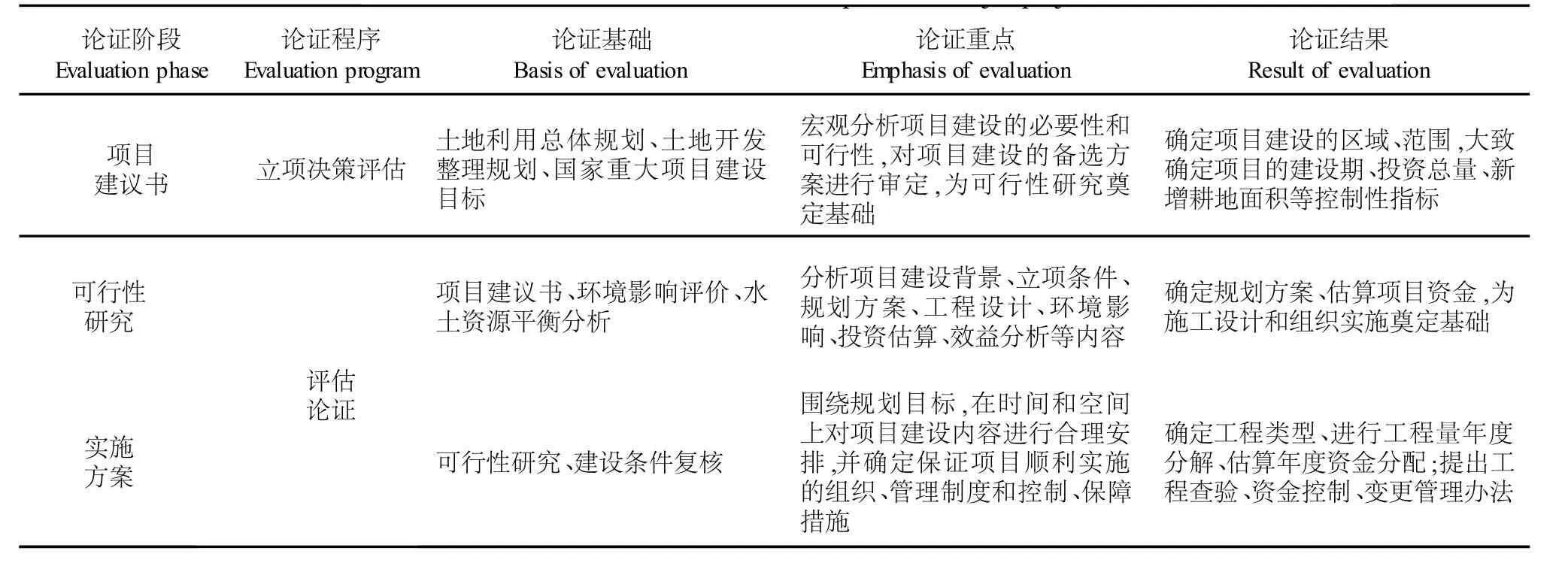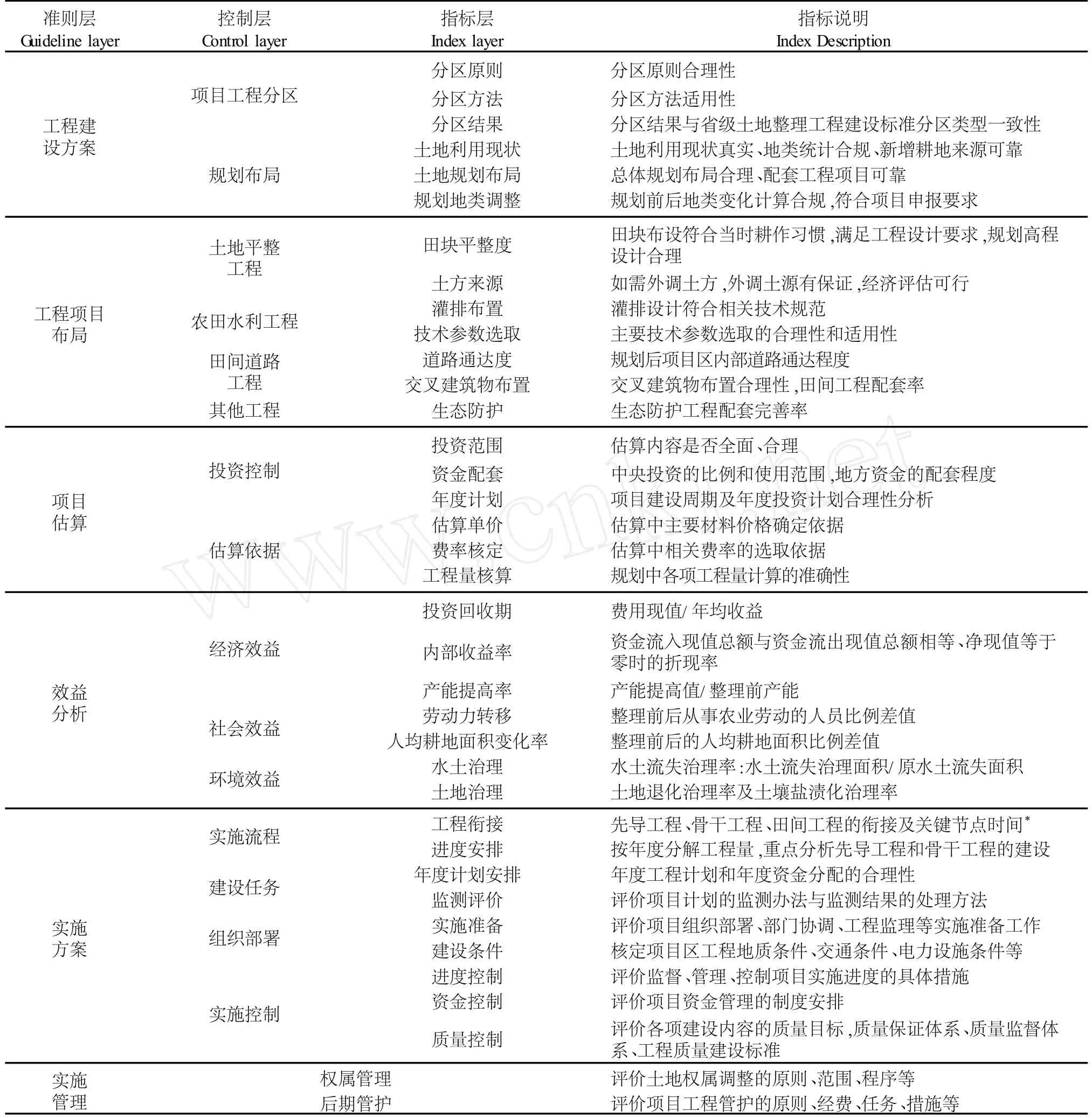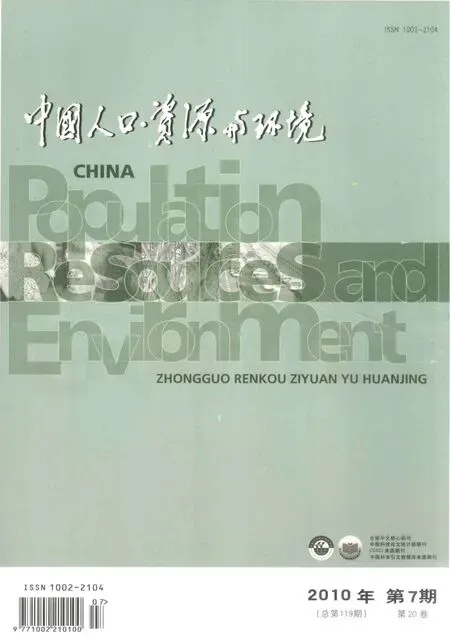中央支持土地整治重大項目評估論證指標體系研究*
金曉斌 李學瑞 湯小櫓 周寅康
(南京大學地理與海洋科學學院,江蘇南京 210093)
中央支持土地整治重大項目評估論證指標體系研究*
金曉斌 李學瑞 湯小櫓 周寅康
(南京大學地理與海洋科學學院,江蘇南京 210093)
國家層面土地整理項目管理工作重點由前期的一般項目審批管理轉向土地整治重大項目的立項決策。目前重大項目尚處于試點申報階段,在管理上基本依托一般項目經驗積累而探索前行,其評估論證的理論基礎、方法體系、技術手段、支持系統尚不健全,難以適應有序管理的要求。此外,面對重大項目規模大、周期長、風險大,系統性及區域性強,環境保護壓力大,實施意義重大等特點,加強重大項目實施前的評估論證,科學進行決策分析尤為重要。文章從項目管理階段和行政管理程序出發,將重大項目評估論證劃分為立項決策評估和評估論證兩個階段,從各階段評估論證的重點出發,分別建立了表征申報資格、申報條件、實施條件;規劃目標、整理條件、生態環境、實施保障;工程建設方案與布局、項目估算與效益分析、實施方案與管理等控制要求的評價指標體系,并就評估論證綜合評價進行了討論,以期為重大項目評估論證實踐提供參考。
土地整治;重大項目;評估論證;指標體系
1997年《關于進一步加強土地整理切實保護耕地的通知》(中發[1997]11號),明確“實行占用耕地與開發、復墾掛鉤政策”、“按照土地利用總體規劃的要求,通過田、水、路、林、村建設綜合整治,搞好土地建設,提高耕地質量,增加有效耕地面積,改善農業生產條件和環境”的土地整理內涵以來,我國土地整理制度及其管理方式經歷了實踐探索、逐步規范,并不斷深入的發展歷程[1-2],截止至2006年底,國土資源部和財政部共安排國家投資土地整理項目(以下簡稱“一般項目”)8批2 320個,建設規模162.6×104hm2,規劃新增耕地面積37.3×104hm2,預算投資總額297.9×109元[3]。2006年后,土地整理內涵和國家層面的項目管理方式都發生了變化。在土地整理內涵上,開展農村土地整治上升為國家戰略部署,提出土地整理要注重從項目實施向制度設計轉變,使農村土地整治成為推進社會主義新農村建設和城鄉統籌發展的新平臺,并正式寫入2009年中央1號文件和政府工作報告,形成了以村莊規劃整治為突破口,以土地整理復墾為重點,以城鄉建設用地增減掛鉤試點為動力的“整合各類資金,整體規劃、整體推進”田水路林村“綜合整治”。在項目管理方式上,進行了由國家審批向省級國土資源部門審批轉變;由國家總負責向國家監管省級國土資源部門總負責轉變;由國土資源部門推動向地方政府和部門共同推動轉變[4]。國家則集中部分中央分成新增建設用地有償使用費重點支持經國務院批準、實施效果明顯、補充耕地規模大的土地整治項目,即中央支持土地整治重大項目(以下簡稱“重大項目”),并于2008年底開展了首批重大項目的試點申報工作。與前期已在全國范圍廣泛開展的一般項目相比,重大項目具有規模大、投資多、周期長、風險高、區域影響強烈等特點[5],加強重大項目實施前的評估論證,科學進行決策分析尤為重要。從實現重大項目規劃目標、確保實施效果出發,本文在劃定重大項目評估論證階段基礎上,分別建立了立項決策指標體系與評估論證指標體系,并就評估論證綜合評價進行了討論,以期為重大項目評估論證提供參考。
1 重大項目評估論證程序
根據重大項目的內涵與特點[5],借鑒一般項目的管理經驗,中央主管部門重大項目評估論證主要圍繞項目建議書、可行性研究和實施方案等技術資料展開,其中對項目建議書重點進行立項決策評估,對項目可行性研究和實施方案則強調評估論證分析。各論證階段具體內容如表1。

表1 重大項目評估論證階段分析Tab.1 Division of the evaluation phase for major project
2 重大項目評估論證指標體系構建
遵循綜合性、系統性、代表性等指標選取原則,從重大項目內涵出發,本研究建立由立項決策評估與評估論證二個層次評估論證指標體系,其中立項決策評估由門檻指標和評估指標共同組成,評估論證由評估指標組成。
2.1 立項決策評估指標
2.1.1 門檻指標
門檻指標指滿足立項決策評估所必須具備的指標,若其中任一項不能滿足,則項目無法立項,不再進入下一階段評估過程,指標見表2。
2.1.2 評估指標
評估指標是指根據重大項目實施目的、要求及國家相關政策,所篩選的能夠反映影響重大項目立項決策的各類指標,包括規劃目標、整理條件、生態環境、實施保障等四個層次,具體因素集見表3。
2.2 評估論證指標體系
評估論證是在立項決策評估的基礎上,根據重大項目可行性研究和實施方案階段的任務、要求及國家相關政策,從工程建設方案、工程項目布局、項目估算、效益分析、實施方案、實施管理等六方面篩選出各類評估論證指標,具體因素集見表4。
2.3 評估論證綜合評價
根據重大項目的特點,其綜合評價宜采用定性與定量相結合的綜合評價方法。在劃分評估論證階段和確定評價指標體系的基礎上,在評價步驟上,首先,進行評價指標標準化轉換。各評價指標因為性質不同,具有不同數據類型和量綱,各指標數據之間具有不可公度性,難以進行直接比較。因此,在綜合評價前必須把這些指標按某種效用函數歸一化到某一無量綱區間。數據標準化通常采用向量歸一化法、線性比例變換法、極差變化法、標準樣本變換法等方法。其次,確定指標權重。從數學變換的角度,評價對象是由評價指標組成的高維空間點集,綜合評價模型就是一種從高維空間到低維空間的映射,評價過程要求這種映射盡可能的反映評價對象在原高維空間中的分類和排序信息,而指標權重的合理確定是這些信息的具體反映[6]。指標權重確定的方法包括基于決策者的經驗與偏好,通過各指標屬性進行比較而賦權的主觀賦權法(如Delphi、AHP等)和基于各方案相應各屬性的數據而確定權重的客觀賦權法(如主成分分析法、因子分析法、熵值法、物元分析法、灰色關聯度法等)。最后采用線性加權和法作為評價函數求取綜合評價結果。

表2 重大項目立項決策評估門檻指標Tab.2 Threshold indicators on major project decision-making appraisal

表3 重大項目立項決策評估指標Tab.3 Evaluation indicators on major project decision-making appraisal
3 結 語
重大項目建設規模龐大,涉及因素重多,后果影響深遠,如缺乏充分評估與論證,可能導致項目效益低下,國家和群眾利益受到損害。溫家寶總理曾在國土資源部重大項目請示文件上做出:“西北、東北大規模造地要科學論證,充分考慮水資源和生態環境等多種影響因素,此事科學家有不同意見,要充分聽取,歷史上也有深刻教訓,要認真吸取”的重要批示。因此,加強重大項目評估論證科學性、合理性研究,對實現規劃目標、確保實施效果尤為重要。
目前重大項目尚處于試點申報階段,在管理上基本依托一般項目經驗積累而探索前行,其評估論證的理論基礎、方法體系、技術手段、支持系統尚不健全,難以適應有序管理的要求。本文在劃定重大評估論證程序的基礎上,對各階段評估論證體系進行了分析,以期為重大項目科學決策提供參考。
(編輯:王愛萍)

表4 重大項目評估論證指標Tab.4 Indicators on major project evaluation
References)
[1]鹿心社.論中國土地整理的總體方略[J].農業工程學報,2002,18(1):1-5.[Lu Xinshe.General Strategyof Land Consolidation in China[J].Transactions of the Chinese Society of Agricultural Engineering,2002,18(1):1-5.]
[2]王軍,余莉,羅明.土地整理研究綜述[J].地域研究與開發,2003,22(2):8-11.[Wang Jun,Yu Li,Luo Ming.Review on Progress in Land Consolidation[J].Area Research and Development,2003,22(2):8-11.]
[3]金曉斌,黃瑋,易理強.土地整理項目績效評價初探[J].中國土地科學,2008,22(6):57-62.[Jin Xiaobin,Huang Wei,Y i Liqiang.Study on Performance Evaluation on Land Reconsolidation Project[J].China Land Science,2008,22(6):57-62.]
[4]湯小俊,閻炎.土地整理事業十年回眸[J].中國土地,2008,(8):8-11.[Tang Xiaojun,Yan yan.The Decade Land Consolidation Review[J].China Land,2008,(8):8-11.]
[5]李學瑞,湯小櫓,金曉斌,等.土地整理復墾開發重大項目特征與管理模式研究[J].中國土地科學,2009,23(9):59-62.[Li Xuerui,Tang Xiaolu,Jin Xiaobin,et al.Feature and Management Model Research on Large Project of Land Arrangement and Reclamation and Exploitation[J].China Land Science,2009,23(9):59-62.]
[6]金曉斌,張鴻輝,周寅康.農用地定級綜合評價中權重系數確定方法探討[J].南京大學學報:自然科學版,2008,44(1):91-98.[Jin Xiaobin,Zhang Honghui,Zhou Y inkang.Weight Making Methods Studyfor Agricultural Land Gradation Evaluation[J].Journal of Nanjing University:Natural Sciences,2008,44(1):91-98.]
[7]何英彬,陳佑啟,楊鵬,等.農村居民點土地整理及其對耕地的影響[J].農業工程學報,2009,25(7):312-316.[He Y ingbin,Chen Y ouqi,Yang Peng,et al.Rural Residential Land Consolidation and Its Effect on Arable Land[J].Transactions of the Chinese Society of Agricultural Engineering,2009,25(7):312-316.]
[8]倪九派,李萍,魏朝富,等.基于AHP和熵權法賦權的區域土地開發整理潛力評價[J].農業工程學報,2009,25(5):202-209.[Ni Jiupai,Li Ping,Wei Chaofu,et al.Potentialities Evaluation of Regional Land Consolidation Based on AHP and Entropy Weight Method[J].Transactions of the Chinese Society of Agricultural Engineering,2009,25(5):202-209.]
[9]張鳳榮,關小克,徐艷,等.大都市區土地整理與農田水肥管理模式探討:以北京市為例[J].資源科學,2009,31(7):1088-1094.[Zhang Fengrong,Guan Xiaoke,Xu Yan,et al.The Models of Land Consolidation and Soil Fertility Management in Metropolitan Suburb:A Case Study of Beijing City[J].Resources Science,2009,31(7):1088-1094.]
[10]鄧勝華,梅昀,胡偉艷.基于模糊模型識別的石碑坪鎮土地整理社會生態效益評價[J].中國土地科學,2009,23(3):72-75.[Deng Shenghua,Mei Yun,Hu Weiyan.Evaluation on Social and Ecological Benefits of Land Consolidation in Shibeiping T own Based on Fuzzy Model Recognition[J].China Land Science,2009,23(3):72-75.]
[11]李紅舉,林堅,閻紅梅.基于農田景觀安全格局的土地整理項目規劃[J].農業工程學報,2009,25(5):217-222.[Li Hongju,Lin Jian,Yan Hongmei.Planning of Land Consolidation Project Based on Farmland Landscape Security Pattern[J].Transactions of The Chinese Society of Agricultural Engineering,2009,25(5):217-222.]
AbstractWith the connotation of the land consolidation extended and the conception of the land remediation proposed,the working emphasis of the land consolidation project management at national level changed from previous approval and management of general projects to strategymaking of land remediation major project.The current major project is still at the stage of pilot declaration,basically relying on the general project experience accumulation while theoretical basis,method system,technical means and support system of the evaluation and demonstration are not yet perfect,it’s and are difficult to adapt to the requirements of orderly management.Furthermore,because the major projects have characters such as large scale,long cycle,high risk,strong systematization and regionality,serious pressure of environmental protection,and significant implementation meaning,strengthening the evaluation and the demonstration before the implementing of major project and making the scientific decision analysis are particularly important.This study starts with the project management phase and administration management procedure,divides the evaluation and demonstration of major project into two stages of project decision-making and evaluation demonstration on the basis of the focus on each stage's evaluation and demonstration,also establishes respectively the characterization declaration qualification,declaration condition,implementation condition,planning target,organizing condition,ecological environment,implementation safeguard,the control requirements of evaluation index system of project construction plan and layout,project estimation and benefit analysis,and implementation plan and management,etc.Moreover,this study discusses the comprehensive evaluation and demonstration in order to provide reference for the further evaluation and demonstration practices of major projects.
Key wordsland remediation;major projects;evaluation and demonstration;indicator system
Evaluation Indicators Research on Central Support Land Remediation Major Project
JIN Xiao-bin LI Xue-rui TANG Xiao-lu ZHOU Yin-kang
(School of Geography and Ocean Sciences,Nanjing University,NanjingJiangsu 210093,China)
F301.24
A
1002-2104(2010)07-0092-05
10.3969/j.issn.1002-2104.2010.07.015
2010-01-08
金曉斌,博士,副教授,主要研究方向為土地資源管理。
*國土資源部科技項目(No.20071220)、國家科技支撐計劃(No.2008BAB38B06)資助。

